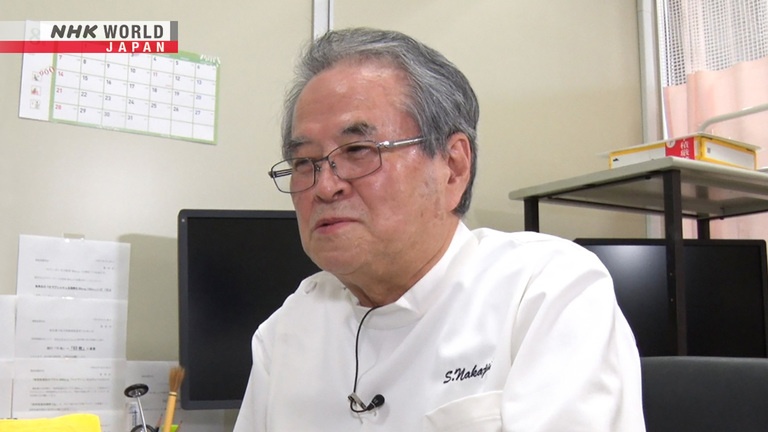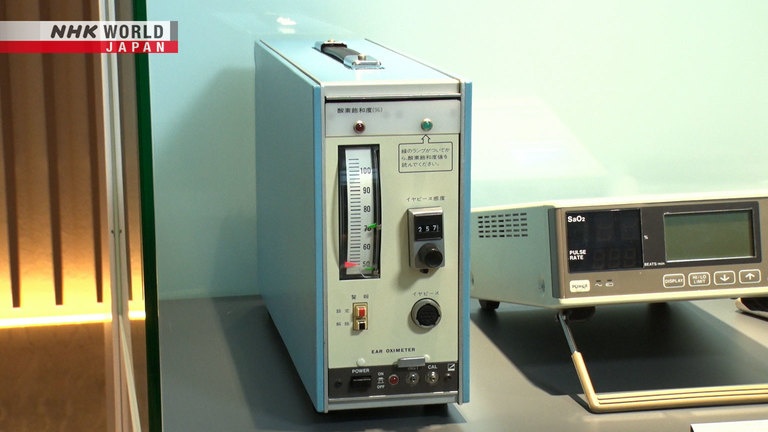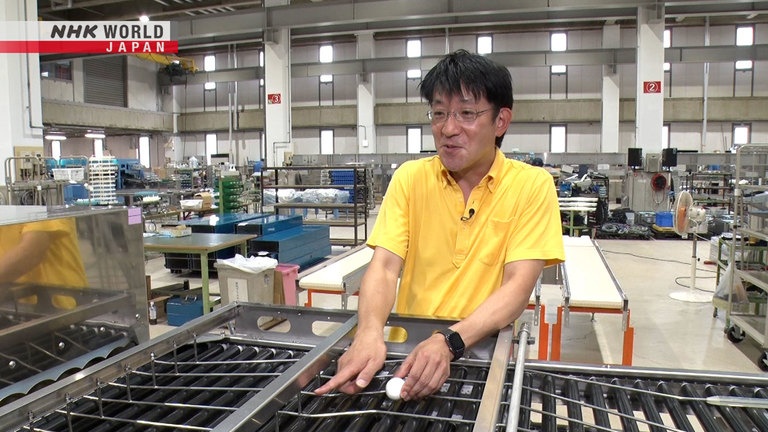Pulse Oximeters / Egg Grading & Packing Systems
The fascinating stories and secrets behind hit Japanese products, plus parts and machines that boast the top share of niche markets. In the first half: pulse oximeters that measure blood oxygen saturation, which have saved many lives during the COVID-19 pandemic. In the second half: egg grading & packing systems which clean eggs, check for cracks, sort and pack them. We introduce these systems that are used in over 70 countries and regions worldwide.



Transcript
"Japan's Top Inventions"
The behind-the-scenes tales of hit products and creations from Japan.
This is "Japan's Top Inventions."
On today's show...
The fight against COVID-19 continues around the world.
We explore a key medical invention that's helped save lives.
Meanwhile, take a look at these eggs.
They're being tapped by many little sticks.
We introduce a unique machine that gets eggs ready for shipping.
Hello, welcome to "Japan's Top Inventions."
I'm your host, Jason Danielson.
In the first half of our show, we take you "Behind the Creation."
Today's topic is this.
Pulse oximeters.
Just clip one on,
and the device measures the oxygen saturation of your blood,
allowing you to monitor your oxygen levels in real time.
They've become widely used during the COVID-19 pandemic,
in which the virus attacks the respiratory system of the patient.
The first device came on the scene some 50 years ago.
A medical equipment manufacturer's R&D center in Saitama.
On display here...
This was the first one we developed.
The world's first pulse oximeter, invented in 1975.
It measures the oxygen saturation of your blood using your pulse.
The measurement was taken from your ear lobe.
It was invented by Aoyagi Takuo, an engineer at the company.
He passed away in 2020 at age 84, during the pandemic.
The Institute of Electrical and Electronics Engineers in the US
gave it an award for innovation in the field of medicine.
We're very proud of it.
Our story begins in the 1940s.
Nagaoka in Niigata Prefecture lies 210 kilometers north of Tokyo.
Aoyagi grew up here.
He was an energetic boy that loved playing outdoors.
One of his favorite spots was the temple and cemetery behind his home.
The sight of the gravestones shaped his perspective on life.
Fuse Masayoshi worked with Aoyagi at the same company.
He remembers what his colleague told him.
Aoyagi saw those gravestones
and it really made him think about people's lives.
He thought, "What can I do?"
He wanted to create something useful, and share it with the world.
Aoyagi went on to study electrical engineering at university
and got a job developing new products
for a medical equipment manufacturer.
But what would he make?
Aoyagi had an idea.
Measuring the volume of blood pumped by the heart.
It was vital information when checking the heart's condition.
How much blood does the heart pump to keep us alive?
And how much blood is in there?
Those are vital parameters at the hospital.
Aoyagi's goal was to develop a device
that would clip onto the skin
and measure the volume of blood pumped by the heart.
Something developed in the US caught his eye.
An ear oximetry device.
It used the color of blood to measure oxygen saturation.
Blood that's high in oxygen is bright red.
Blood that's low in oxygen is much darker.
To use the American oximeter,
the earlobe was first warmed to expand the blood vessels,
before attaching the device.
Light was shone through the earlobe.
By analyzing the amount of light
absorbed by the varying colors of blood,
the oxygen level could be found.
The equipment was rarely used in hospitals at the time.
After days of research, Aoyagi realized something.
Ear oximetry measured the light absorption of the skin, veins,
and arteries in the earlobe.
The measurement graph showed a consistently jagged line,
which reflected a pulse.
The skin doesn't move.
And there's no pulse in our veins.
However, arteries pulse in time with the heart
as it pumps blood through our bodies.
The presence of a pulse identifies the arteries.
The pulse is the movement in our arteries.
There isn't one in our veins because there isn't enough pressure.
When you see a pulse waveform, that's arterial blood.
That was the eureka moment. The key concept.
By focusing on only the vessels with a pulse,
the arteries which carry oxygenated blood,
Aoyagi could get a more accurate measurement of oxygen saturation.
This idea was the heart of the pulse oximeter.
Nine hundred and thirty kilometers north of Tokyo, in Hokkaido,
there was a doctor that was interested in Aoyagi's idea.
Nakajima Susumu, who worked at a university hospital.
He explains that at the time,
the way to check a patient's oxygen levels during surgery
was to draw arterial blood.
We had to draw arterial blood constantly, and then analyze it.
It was a huge amount of work.
A monitor or device that could easily check oxygen levels
was something out of a dream.
With pressing needs from doctors on the ground,
Aoyagi built a prototype at Nakajima's request.
He attached it to his own ear...
Then pinched his nose,
holding his breath to see if the device would pick up the change.
Holding your breath causes your oxygen levels to fall.
He'd stop breathing to see if it could actually pick up that change.
He turned himself into a test subject basically,
testing it over and over.
He was totally dedicated.
March 1974, a year after development began.
Dr. Nakajima received the very first machine.
This graph shows the results from the initial experiments on animals.
The oxygen levels measured
using the device matched the results from blood tests.
The next test was on patients that had breathing difficulties
after undergoing treatment for tuberculosis.
The device was attached to the ear.
Then...
The moment we flicked the switch,
the oxygen saturation levels appeared at once.
Our experiments proved that measurement was possible.
Everyone was shocked at the strength of the results.
And so, by focusing on the pulse in the arteries
to measure oxygen saturation,
the first pulse oximeter was complete.
Aoyagi decided to debut his invention
at a medical equipment conference in Osaka.
There, he introduced his creation.
But attendees were largely uninterested.
Togawa Tatsuo headed the conference at the time.
He remembers the occasion.
People weren't interested.
If you considered the new focus on using pulse,
it was a groundbreaking technique.
I thought it was interesting,
but I never dreamed it would become such an important invention.
Then, out of the blue, Aoyagi was told by the company,
"There's no market for this product."
The plug was pulled on his project.
Aoyagi was promoted to manager,
but he was given new research projects.
Takeda Sunao was a younger colleague and still remembers it vividly.
Aoyagi must have been so frustrated.
He came up with the principle.
And as an engineer, you want to see things through to the end.
Half a century ago,
the value of a pulse oximeter wasn't properly recognized in Japan.
But that wasn't the case everywhere.
Across the ocean, people were beginning to notice their true value.
In the late 1970s in the US,
there were incidents of patients under anesthesia
dying from an undetected lack of oxygen during surgery.
There were calls for a device
that could monitor the patient's oxygen levels.
A Japanese manufacturer,
and rival to Aoyagi's company,
had set its sights on the US.
June 1977.
This rival had also turned their attention to the pulse in arteries.
It developed a pulse oximeter that measured from the fingertip.
Miwa Atsushi handles the company's marketing.
He explains what was happening back then.
The thinking at the time was that
new medical technology and products had to first be accepted in the US.
Once they had taken root there,
we saw them being reimported back to Japan.
The company decided to focus its efforts on the US.
They first tried
with the anesthesiology department at Stanford University.
Their response?
"Interesting, but can you make it smaller?"
The team returned to Japan and quickly began making improvements.
But while they were still hard at work in 1982...
a small US start-up had produced its own compact product.
They put it on the market before any Japanese manufacturer,
quickly winning attention from medical professionals.
It took off in the US.
But what about the company
that had withdrawn after developing the world's first pulse oximeter?
It decided to ask a certain someone to make up for lost time.
Aoyagi Takuo, the man who had invented the first device.
But Aoyagi was conflicted.
"Pulse oximeters took off
because of improvements made by another company."
"Even though I invented the device, I couldn't achieve what they have."
Then one day...
Aoyagi received a phone call.
A professor at the University of California wanted to interview him.
John Severinghaus was a world authority on respiratory physiology.
Pulse oximeters had made a large contribution to medicine,
and he was studying their history.
January 1987.
The professor arrived in Japan to interview Aoyagi in a Tokyo hotel.
He was accompanied by Nakajima Susumu,
the doctor from Hokkaido that had asked Aoyagi to make the first device.
He remembers that meeting.
Dr. Severinghaus was a professor of anesthesiology, a world authority.
He discovered that the pulse oximeter,
which was so vital during operations,
had first been invented and used in Japan.
He wanted to learn more.
During the interview, the professor unleashed a flood of questions
about the development process.
Aoyagi spoke in detail about the work he had done.
Three months later, after returning home,
Dr. Severinghaus released a paper.
It was about the history of pulse oximeters.
And in it?
A photograph of Aoyagi was prominently featured.
The paper stated that Aoyagi was the first to develop
the principle used by pulse oximeters.
When Dr. Severinghaus met Aoyagi in Tokyo,
he recognized that the work was world-class, and correct.
Aoyagi was over the moon.
And so, Aoyagi's hard work wasn't lost to time.
In 2012, he received a Lifetime Achievement award
at a US medical symposium.
Aoyagi smiles happily alongside Dr. Severinghaus.
Pulse oximeters eventually came to be used around the world.
How do experts view this invention?
We're joined by anesthesiologist Dr. Miyasaka Katsuyuki to learn more.
Welcome to the show.
Thank you.
How do you see the achievements of Dr. Aoyagi,
who developed the first pulse oximeter?
Arterial blood moves in pulses.
By focusing on that pulsation,
the oxygen saturation of arterial blood can be measured.
Dr. Aoyagi invented this principle.
If you shine light through a finger,
it's going to hit skin, veins, arteries, bones, fat,
and all kinds of tissue in there.
The idea of only capturing information from the arteries
was the breakthrough.
How was oxygen saturation in the blood measured
before pulse oximeters?
Until 1970, doctors would do a visual check of a patient's complexion,
or draw blood from an artery and analyze its oxygen content.
Those were the only options.
Pulse oximeters made it so simple.
We clip on a device and instantly get a reading
on whether a patient's oxygen levels are okay.
How have pulse oximeters changed medical care?
We can read oxygen levels for patients of all ages and conditions,
whenever we want.
We can reliably monitor the oxygen supply of a critical patient.
Operations that might have been risky
now have an extra layer of security for the patient.
That's its greatest merit, I think.
Its biggest contribution.
Thank you for your time. It was good to talk to you.
Thank you.
"Top Niche Creations."
Our next segment is "Top Niche Creations."
We've previously showcased machines that can make tasty skewers,
"dorayaki," or food with fillings.
This time, we're looking at these. Eggs.
Well, we're not looking at making eggs, but the machine that packs them.
Too easy, you say?
Not so fast.
Eggs are delicate. You can't sell a cracked egg.
We visited a company that knows how to put all their eggs in one basket.
A machine manufacturer in Kyoto.
Welcome!
It's a company of about 190 employees,
and they've focused solely on eggs for over 40 years.
Check out the poster!
(Eat at least two eggs a day!)
We're shown to a machine that's almost ready to be shipped.
That's our machine.
Can you see it? An L-shaped assembly around 30 meters long.
It's called an egg grading and packing system.
Pass eggs through the system,
and irregular ones are automatically removed.
The remaining good eggs are packed.
But how does it work? Takaishi Yasuhiro takes us through it.
Eggs are placed on the conveyor in any orientation.
Watch which way the eggs are facing.
They all come out the same way.
Let's see how it works with just one egg.
It rolled over!
Eggs naturally roll toward their pointed end.
They end up by these bars, which turn them round.
That aligns the eggs.
But why does it matter if they all point the same way?
Well, since the yolk of an egg is less dense than the white,
it floats up.
If the pointy end faces upwards,
the yolk pushes against the shell, and can burst.
There's a small air pocket on the rounder end,
so if that's at the top,
the air will cushion and protect the yolk from damage.
Next, the eggs are washed in water that's 60 degrees Celsius, and dried.
Then a light is shone through each egg.
This is an inspection mechanism to check for flaws.
It can identify issues like this.
A bit of blood is attached to the yolk.
We can spot blood by detecting the hemoglobin it contains.
If the system spots any issues,
it will remove the egg in question through a special gate.
After checking for flaws, the good eggs are packed.
Components called "fingers" pick up
and drop them directly into packages.
Eggs are delicate, so the shape and material of the fingers,
and the falling height are all carefully calculated.
The system can grade and pack 60,000 eggs in one hour.
It's currently used in over 70 countries and regions around the world.
We have an 80% market share in Japan, and 20% abroad.
Our goal is to pack eggs around the world,
and we're all working towards that.
The company has a big share of the egg-system market.
It was established in 1964.
At first, the company made control panels for factories.
As the Japanese economy grew, so did consumption of eggs.
At the time, eggs were packed by hand.
The company spotted the potential
for automation and invented a new machine.
The issue was the fragility of eggs.
After leaving the fingers, momentum kept the eggs moving forward.
Sometimes, they smashed into another egg, cracking both.
Eggs have to be carried softly and gently.
They're also packed close together.
So achieving a soft landing
while not letting the eggs hit each other was difficult.
After much trial and error, the company came up with a solution.
The eggs would be turned around as they were dropped.
But did it work?
Here is actual footage of the machine.
The eggs fall straight without any collisions.
A safe landing.
The next issue was finding cracks.
How to spot minute imperfections invisible to the eye?
This mechanism was the answer.
Can you see a crowd of thin sticks flittering about?
What are they doing?
Little sticks like cotton buds tap the eggshells.
The sound they make tells us if there's a crack or not.
Let's watch in slow motion.
Each egg is tapped a total of 16 times as it rolls.
But how different is the sound? Let's find out.
It's a subtle difference.
Takaishi clarifies with another example.
This is an uncracked bowl. Let's tap it.
There's a slight echo to the sound.
But with a cracked bowl.
It's dull. No echo.
Our clients want us to spot even very tiny cracks.
Our system was able to meet that challenge.
Recently, the company has also made a machine
for inspecting the eggs after they're packed.
A small camera photographs the eggs,
and a computer analyzes the picture.
It can pick up any cracks right away.
Maybe the next egg you eat
will have been packed with this company's machine.
That's all for this episode of "Japan's Top Inventions."
We'll leave you with what came next
for the pulse oximeters from the first half of the show.
See you next time! And stay inventive.
(Aoyagi Takuo passed away in 2020, aged 84.)
(Pulse oximeters proved their worth in treating COVID-19 that same year.)
(They helped save lives by monitoring oxygen levels in pneumonia patients.)
(Dr. Nakajima played a role in the oximeter's invention.)
(He looks back on that achievement.)
Pulse oximeters are used in places like ICUs and critical care units,
and while patients are under anesthetic.
They've changed the front lines of medicine.
There's no other medical tool like it.